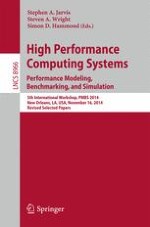2015 | Book
High Performance Computing Systems. Performance Modeling, Benchmarking, and Simulation
5th International Workshop, PMBS 2014, New Orleans, LA, USA, November 16, 2014. Revised Selected Papers
Editors: Stephen A. Jarvis, Steven A. Wright, Simon D. Hammond
Publisher: Springer International Publishing
Book Series : Lecture Notes in Computer Science
